First report of downy mildew on Plantago major caused by Peronospora alta in Brazil
C. D. de Souza A , R. W. Barreto B C and D. J. Soares BA Departamento de Agronomia, Universidade Estadual de Maringá, Av. Colombo, 5790, 87020-900, Maringá, PR, Brazil.
B Departamento de Fitopatologia, Universidade Federal de Viçosa, 36570-000, Viçosa, MG, Brazil.
C Corresponding author. Email: rbarreto@ufv.br
Australasian Plant Disease Notes 3(1) 78-80 https://doi.org/10.1071/DN08031
Submitted: 25 May 2008 Accepted: 4 June 2008 Published: 16 June 2008
Abstract
Peronospora alta is recorded for the first time causing downy mildew on Plantago major (Plantaginaceae) in Brazil.
Plantago major, common plantain (local name in Brazil: tanchagem), is a small biennial herb that belongs to the plantain family (Plantaginaceae) and is native to Europe. In Brazil it is widely cultivated as a medicinal plant and used as a diuretic, cicatrizer and expectorant among others (Lorenzi and Matos 2002). However, despite such uses it is generally regarded as a noxious agricultural and garden weed (Heywood et al. 2007). There are relatively few studies of diseases occurring on members of the plantain family in Brazil and only three fungal species have been recorded on P. major (Mendes et al. 1998).
Since November 2000, a downy mildew disease has been observed attacking P. major cultivated in plots in a small medicinal garden of the campus of the Universidade Federal de Viçosa (state of Minas Gerais, Brazil). The disease was particularly intense during wet periods of the year. Samples of diseased material were collected, dried in a plant press and deposited at the herbarium of the Universidade Federal de Viçosa (Herbarium VIC 30560) for later studies. Only recently (January 2008) this disease was studied in more detail for a full elucidation of its aetiology. Both dried specimen and freshly collected fresh material were examined.
Symptoms on living leaves started as chlorotic areas on the lamina with well defined borders adaxially. Abaxially such yellowed tissues were covered with a grayish fungal growth. As the disease advanced, the tissue became necrotic and brown and leaves blighted and died (Figs 1–3).
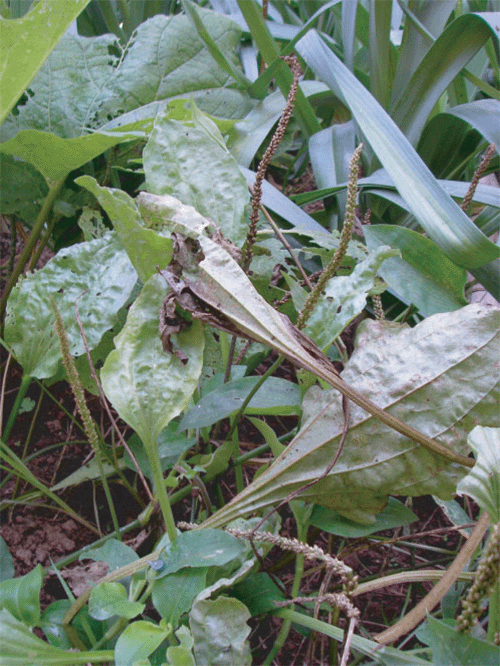
|
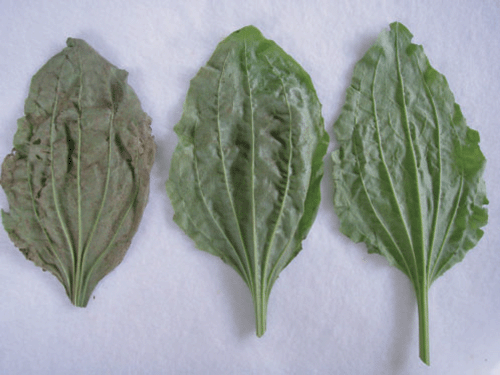
|
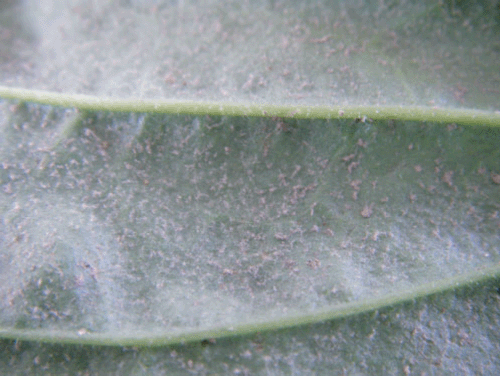
|
Slides containing the fungal structures were mounted in lactophenol and observed with a light microscope (Olympus BX 51). The fungus had the following morphology: sporangiophores 325.5–869.0 × 6.0–9.5 µm, base slightly swollen, 9.5–12.5 µm wide, main trunk cylindrical, 268–452 µm high, branching dichotomously 5–8 times, terminal branches 6.0–28.5 µm long, tapering and curved; sporangia deciduous, mostly ovoid, sometimes globose to ellipsoid, 22.0–30.0 × 16.0–25.0 µm, pale-brown (Figs 4–5). No oospores were observed in sections of leaf tissues.
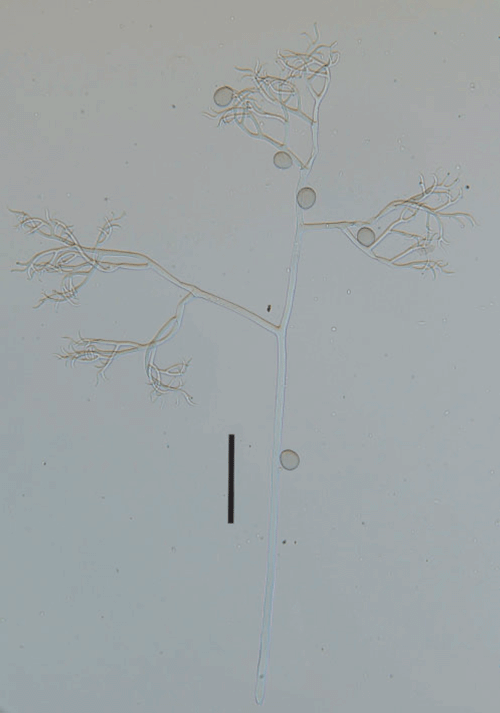
|
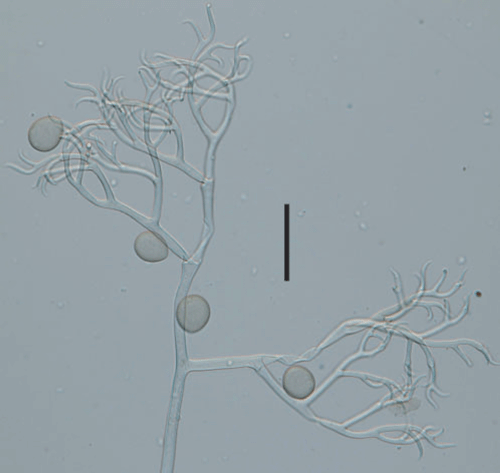
|
This fungus clearly belongs to the oomycete genus Peronospora. The status of Peronospora species described on the Plantago is somewhat confused. There are six published names, but apparently only four are accepted (Francis 1981; Dick 1998), and at least three of those species have been recorded on P. major. These are: P. alta, P. plantaginis and P. akatsukae (Francis 1981). There is little distinction between these three species. Peronospora akatsukae was only recorded once from Japan (Ito and Murayama 1943) and has a similar morphology to P. alta. Distinction between these two species should be verified with modern molecular tools. Peronospora plantaginis is recorded from Bulgaria, India, Korea, Poland and North America (Farr et al. 2008) and can be easily distinguished from other Peronospora on P. major by its larger conidia that are distinctly pointed basally and also somewhat pointed apically (Shaw 1949). Peronospora alta is the most frequently recorded species and most widespread species, with many records in Asia, Europe and North America (Farr et al. 2008). It has also been recorded from South America, in Argentina (Francis 1981). The fungus morphology, from the Brazilian specimen, was compared with that described for the three species previously recorded on P. major. It can be easily separated from P. plantaginis based on conidial/sporangial morphology. At present the Brazilian specimen is better placed under P. alta. Peronospora alta and P. akatsukae are similar morphologically and it is possible that P. akatsukae is conspecific with P. alta. If such synonymy becomes recognised, then the name P. alta has priority over P. akatsukae. Peronospora alta has already been recorded from a neighbouring country from Brazil (Argentina) and is the most widespread species of the three recorded on this host. This is the first record of Peronospora alta from Brazil.
Francis SM
(1981) Peronospora alta. CMI Descriptions of Fungi and Bacteria 683, 1–2.

Ito S, Murayama D
(1943) Notae mycologicae Asiae Orientalis IV. Transactions of Sapporo Natural History Society 17, 160–172.

Shaw CG
(1949) Nomenclatural problems in the Peronosporaceae. Mycologia 41, 323–338.
| Crossref | GoogleScholarGoogle Scholar |



